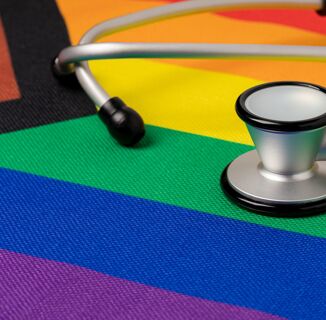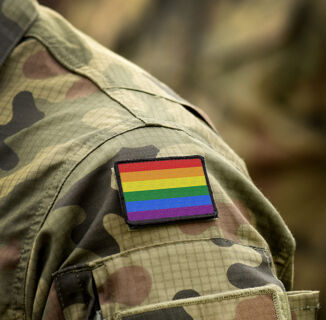More than 20 years ago, when she was still in junior high, the strangest thing happened to Gail Maestas: a boy showed her kindness. It was before she knew she was trans, and kids were tormenting her with anti-gay slurs and violence.
“We met in art class,” Maestas remembers. “I was drawing something and he’s like, ‘That’s really cool.’”
For a few months, over the summer into ninth grade, she hung out with that boy and got to know him. They entered high school together. And then, for whatever reason, she started to curl back up into herself and shut him out.
“I never thought another thing about it until one day his name was in the headlines,” she said.
That kind boy, Aaron McKinney, killed Matthew Shepard in 1998 in the most infamous reported anti-gay crime in American history.
Maestas, whose name has been changed for this story because she fears for her safety, made a decision after that. She still lives in Wyoming.
“I’m never coming out,” she told herself. “I’m never telling anyone. Never never. And I held true to that for many years.”
A year ago, Maestas acknowledged to herself that she was trans, but she lives in constant fear. She is visibly gender non-conforming and Latinx.
When she went to the store recently, she hid her painted nails in her pockets, refusing to even hold items for a friend.
“People will actively yell at me, and a lot of my fear comes from the yelling,” she said. “My dream is to move somewhere that’s so queer that I go into grocery stores and I never think about who’s in the aisle next to me or whether they’re looking at me.”
Maestas has always wondered if she didn’t dodge a bullet with McKinney 20 years ago. And she worries not much has changed in Wyoming since.
This year is expected to be the deadliest on record for trans people, topping only 2017 which saw 29 trans people killed.
But a large swath of the country doesn’t seem to be impacted by the spike in violence, and Wyoming is part of that patch. This year, GLAAD started mapping the location of every transgender murder since the start of 2015, in an effort to examine violence against trans people systemically.
The map reveals a stunning fact: the entire Mountain West region of the county has reported almost no transgender murders over the last four years.
Over the last four years, Arizona reported two murders, and New Mexico one. Colorado and Idaho each had one respectively. But Montana, Nevada, Utah, and Wyoming reported no deaths. The trend continued as far as the Dakotas and Nebraska, the latter of which was the infamous site of the murder of trans man Brandon Teena in 1993.
“I think as someone who has been collecting this data and looking at it mostly on spreadsheets for close to a decade, this was the first time where I’ve seen the visual impact of multiple years,” said Sue Yacka-Bible, communications director at GLAAD.
Yacka-Bible spent 11 years working at the New York City Anti-Violence Project (AVP), which has tracked anti-LGBTQ hate violence for two decades. The mapping project, she says, raises new questions about the accuracy of reporting and the availability of LGBTQ resources for people in the Mountain States.
“I think it opened up a lot of possibility for learning so much more about homicides that we’ve been paying more and more attention to as a community,” Yacka-Bible said. “But now we have to move beyond just counting the number of people who were killed and really look at the lived reality — particularly of Black trans women and trans women of color in this country.”
Two years ago, Mic produced an examination of violence against trans people that shows that trend continues back to at least 2010.
But why is an entire portion of the country not reporting transgender homicides in a moment of unprecedented violence? Experts can’t pinpoint a single answer. Mostly, the research hasn’t been done.
The Population Explanation
The most obvious answer appears to simply be that fewer transgender people live in the Mountain West. In 2016, LGBTQ think tank the Williams Institute estimated the number of trans people in every state. Researchers totaled the least number of trans people living in the northwest region of the country, except for Washington and Oregon, which reported higher populations.
Wyoming, which had the lowest total estimate of trans people at 1,400, hasn’t had a single trans homicide in the past three years. North Dakota, which trails right behind at 1,650, hasn’t either.
Jody Herman, who co-authored the Williams Institute report, said it’s difficult to compare the two maps and draw a single conclusion.
“We don’t really have good data on trans people who die for any good reason, who die from suicide and homicide because we really don’t collect those statistics in any official way,” Herman said.
But, Herman added, if population plays a role, it’s not simply a matter of totals.
“The places where there are less trans homicides are just less densely populated it seems,” Herman said. “This has to be associated with population density.”
But the two maps do not exactly correlate. Washington, for example, ranks close to the top of the list for trans population density at 11th, but reported no murders in the time GLAAD mapped them. Minnesota is also closer to the top at 20th, and also had no reported deaths. Louisiana, which sits between the two at 17th, reported six trans murders.
Gun Violence Overlay
The map of trans murders also bears a striking resemblance to maps tracking gun incidents in the U.S.
The Gun Violence Archive, a non-profit that tallies gun deaths and incidents across the country, has found that shootings are largely concentrated on the coasts, the Midwest and in the South.
The Mountain States report just scattered incidents each year in comparison. Those numbers are worth noting in 2018, which so far has more than 44,800 gun incidents nationwide.
This year, transgender deaths can largely be attributed to gun violence, with 68 percent of them involving a shooting as of October 10.
Gun incidents, however, have been reported at high rates in areas where trans homicides have not been reported in recent years, like Washington and Minnesota, and most notably the area around Salt Lake City, Utah.
Race And Gender Intersecting
There is another map in Herman’s report that is perhaps more telling. That map is a breakout of the race and ethnicity of trans people across the county.
States with the highest concentration of trans people of color, Black trans people in particular, tend to have the highest reported trans homicides.
Ceyenne Doroshow, founder of GLITS, an organization that advocates for trans sex workers, states simply that trans homicides don’t really happen in the Mountain West “where there are no Black trans women.”
Women of color made up 81 percent of last year’s transgender homicides, according to data compiled by NCAVP. Of this year’s 22 reported murders, 15 have been Black trans women.
The Williams Institute map shows that trans people who do live in the Mountain States are overwhelmingly white. Montana’s trans population, for example, was found to be 85 percent white with less than 50 Black trans people in the whole state. White people made up 82 percent of Wyoming’s trans population; Black trans people were just one percent of the total.
“I’m in New York City,” said Doroshow. “Imagine the girls that are in the South. Imagine the girls that are in regions where there are marginalized numbers of Black trans women, where it’s already dangerous to be trans.”
Doroshow has a strange and troubling task ahead of this year’s International Day to End Violence Against Sex Workers on Dec 17.
She is supposed to read the names of transgender women who have been murdered, but this year feels different. That is especially true for trans women who do sex work, who are overrepresented in death counts but whose lives are often reduced to statistics in death due to stigma.
“How do I not only have this event in good taste, but have the equipment to do an event like this and make sure people don’t leave traumatized by a roll call of numbers?” Doroshow asked. “It seems like every other day, every couple of days, there’s a new Black trans woman somewhere in this world taken out, and there’s no accountability. There’s nobody saying that this is turning into a fashion.”
Disparity in Reporting
In August, ProPublica reporters Lucas Waldron and Ken Schwencke published a groundbreaking look at trans homicides that explored the issue of “deadnaming,” or using a trans person’s former birth-assigned name. ProPublica found that since the start of 2015, victims were misgendered or deadnamed in a staggering 74 of 85 cases.
The story points out that misidentification can slow investigations because it confuses a victim’s friends, and it fosters distrust among LGBTQ community members who might otherwise aid law enforcement.
But deadnaming has another consequence. Often times, it erases the memory of transgender people altogether.
In June, Diamond Stephens was gunned down in Meridian, Miss. It was more than a month before trans writer and activist Monica Roberts reported on her death on her blog TransGriot.
“This is why we harp on media and police respecting the pronouns and lives of trans people,” Roberts wrote. “This woman was killed in June, but the community is just now finding out about it because of media and police misgendering.”
This raises the question of whether some deaths in the Mountain West are simply missed.
“You know, it always starts at the community level, and so if you have police who are misreporting names, gender, and pronouns, and then that misinformation is being repeated in the press, it doesn’t give local community members the opportunity to even know that there’s inaccuracy here,” said Yacka-Bible.
Yacka-Bible raises the possibility that in areas with lower population density, news may not travel, and LGBTQ organizations that track local headlines are fewer and farther between.
Jerilyn Poole, founder of Queer Meals in Provo, Utah, says the LGBTQ community there is cohesive, and word spreads, even if many outside the community still misgender trans people.
“I believed it would get picked up by most people,” said Poole.
Another organization that tracks news at the edge of the Mountain States is Tristate Transgender, a group that works to create awareness and provide support for trans people in Minnesota, North Dakota, and South Dakota.
Tristate Founder Rebel Marie says at least in those states, she doesn’t think there have been unreported murders. However, she said, police are extremely reluctant to acknowledge hate crimes or identify trans people as such.
“If I had a trans woman who was killed in Jamestown, North Dakota that would never be reported as a trans person,” Marie said. “That would never be reported on the news.”
Maestas, too, suspects there could be an underreporting problem in Wyoming due to police misgendering.
“If I die tomorrow because of this, no one is going to write that down,” she said. “They won’t write that I’m transgender. ‘You can’t prove that so, therefore, we don’t have to mention that.’ I’m so sure.”
In this, Yacka-Bible sees a challenge for national LGBTQ groups.
“I think for me it’s really a matter of this is something that really deserves all of our time and attention,” she said. “Creating this map really helps us to see that.”
To that, Maestas, has one response: “I wonder if you’re in for the fight of your life.”
Image via Getty
Help make sure LGBTQ+ stories are being told...
We can't rely on mainstream media to tell our stories. That's why we don't lock our articles behind a paywall. Will you support our mission with a contribution today?
Cancel anytime · Proudly LGBTQ+ owned and operated
Read More in Impact
The Latest on INTO
Subscribe to get a twice-weekly dose of queer news, updates, and insights from the INTO team.
in Your Inbox













